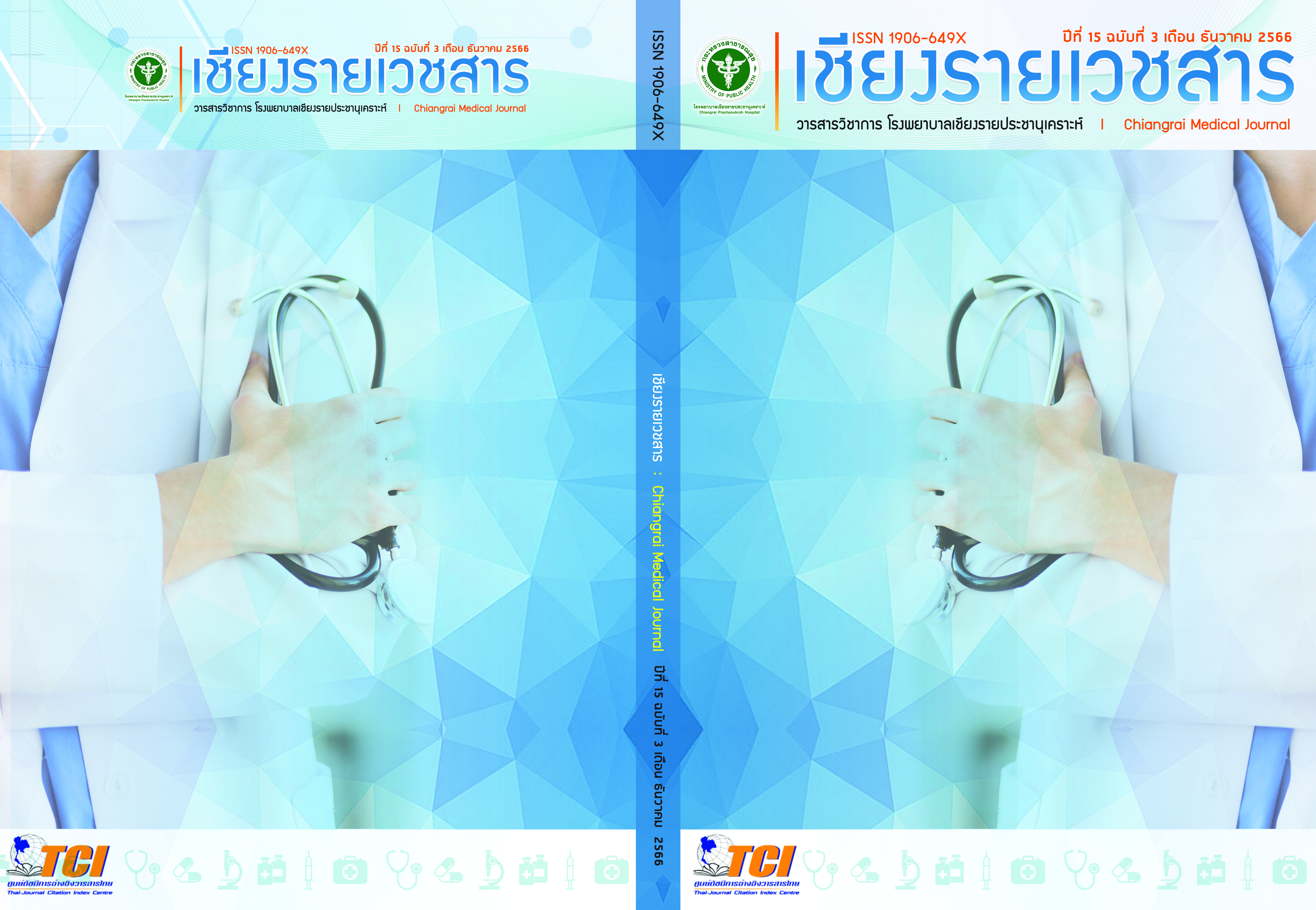เปรียบเทียบระยะเวลาในการเข้าทำเอกซเรย์คอมพิวเตอร์สมองและการได้ยาละลายลิ่มเลือดในผู้ป่วยโรคหลอดเลือดสมองขาดเลือดเฉียบพลันที่มาห้องฉุกเฉินโดยระบบการแพทย์ฉุกเฉินกับการเข้ารับบริการเอง
Main Article Content
บทคัดย่อ
ความเป็นมา โรคหลอดเลือดสมองเป็นภาวะฉุกเฉินทางการแพทย์และเป็นสาเหตุการเสียชีวิตอันดับ 2 ในกลุ่มผู้สูงอายุรองจากโรคหลอดเลือดหัวใจ ในผู้ป่วยที่รอดชีวิตจะมีความพิการระยะยาว การรักษาผู้ป่วยโรคหลอดเลือดสมองขาดเลือดเฉียบพลัน (acute ischemic stroke) ต้องได้รับยาละลายลิ่มเลือดภายใน 3-4.5 ชั่วโมง ผู้ป่วยโรคหลอดเลือดสมองขาดเลือดเฉียบพลันที่เข้ารับบริการผ่านระบบการแพทย์ฉุกเฉินคาดว่าจะเข้าถึงการดูแลรักษาได้เร็วขึ้น
วัตถุประสงค์ เพื่อเปรียบเทียบระยะเวลาในการให้ยาละลายลิ่มเลือด rt-PA และระยะเวลาในการเข้าทำเอกซเรย์คอมพิวเตอร์สมองในผู้ป่วยโรคหลอดเลือดสมองขาดเลือดเฉียบพลันที่เข้ารับการรักษาผ่านระบบการแพทย์ฉุกเฉินเทียบกับผู้ป่วยที่เข้ามารับบริการเองในห้องฉุกเฉิน
วิธีการศึกษา เป็นการศึกษารูปแบบ therapeutic efficacy research และ retrospective cohort study โดยเก็บรวบรวมข้อมูลย้อนหลังจากบันทึกเวชระเบียนในช่วงวันที่ 1 ตุลาคม 2562 – 30 กันยายน 2564 และวิเคราะห์ข้อมูลโดยใช้ t-test, rank sum test, exact probability test, univariable และ multivariable linear regression analysis
ผลการศึกษา จากผู้ป่วยทั้งหมดที่ศึกษา 62 ราย แบ่งเป็นเข้ารับบริการผ่านระบบการแพทย์ฉุกเฉิน 36 ราย และเข้ารับบริการเอง 26 ราย การเข้ารับบริการระบบการแพทย์ฉุกเฉินสามารถลดระยะเวลาในการรักษาผู้ป่วยโรคหลอดเลือดสมองขาดเลือดเฉียบพลันอย่างมีนัยสำคัญทางสถิติ ได้แก่ ระยะเวลาที่แพทย์เข้าตรวจในห้องฉุกเฉิน (p=0.026) มี mean difference 2.101 นาที (95%CI, 0.251 – 3.952) ระยะเวลาที่ได้รับยาละลายลิ่มเลือด (p=0.024) มี mean difference 15.173 นาที (95%CI, 2.016 – 28.329) และระยะเวลาที่ได้เข้าหอผู้ป่วยหลอดเลือดสมอง (p=0.008) มี mean difference 18.071 นาที (95%CI, 4.678 – 31.464)
สรุปและข้อเสนอแนะ การเข้ารับบริการระบบการแพทย์ฉุกเฉินสามารถลดระยะเวลาที่ได้รับยาละลายลิ่มเลือดในผู้ป่วยโรคหลอดเลือดสมองขาดเลือดเฉียบพลันได้ จึงควรมีการพัฒนาระบบบริการทางการแพทย์ฉุกเฉินทั้งด้านผู้ให้บริการทางการแพทย์ และการเข้าถึงของประชาชน
Article Details

อนุญาตภายใต้เงื่อนไข Creative Commons Attribution-NonCommercial-NoDerivatives 4.0 International License.
เอกสารอ้างอิง
Powers WJ, Rabinstein AA, Ackerson T, Adeoye OM, Bambakidis NC, Becker K, et al. Guidelines for the early management of patients with acute ischemic stroke: 2019 update to the 2018 guidelines for the early management of acute ischemic stroke: a guideline for healthcare professionals from the American Heart Association/American Stroke Association. Stroke. 2019;50(12):e344-e418.
Heemskerk JL, Domingo RA, Tawk RG, Vivas-Buitrago TG, Huang JF, Rogers A, et al. Time is brain: prehospital emergency medical services response times for suspected stroke and effects of prehospital interventions. Mayo Clin Proc. 2021;96(6):1446-57.
Jantasri S, Tiamkao S, Sirikarn P. Effectiveness of intravenous recombinant tissue plasminogen activator (rtPA) for acute ischemic stroke in Udonthani Hospital versus node-rtPA community hospitals. Thai Journal of Neurology. 2020;36(4)34-57.
Emergency Medicine Statistics Report [Internet]. Nonthaburi: National Institute for Emergency Medicine; 2023 [cited 2023 Aug 23]. Available from: https://ws.niems.go.th/ITEMS_DWH/
Alabdali A, Yousif S, Alsaleem A, Aldhubayb M, Aljerian N. Can emergency medical services (EMS) shorten the time to stroke team activation, computed tomography (CT), and the time to receiving antithrombotic therapy? a prospective cohort study. Prehosp Disaster Med. 2020;35(2):148-51.
Madhok DY, Keenan KJ, Cole SB, Martin C, Hemphill JC. Prehospital and emergency department-focused mission protocol improves thrombolysis metrics for suspected acute stroke patients. J Stroke Cerebrovasc Dis. 2019;28(12):104423.
Lin CB, Peterson ED, Smith EE, Saver JL, Liang L, Xian Y, Olson DM, et al. Emergency medical service hospital prenotification is associated with improved evaluation and treatment of acute ischemic stroke. Circ Cardiovasc Qual Outcomes. 2012;5(4):514-22.
Oostema JA, Nasiri M, Chassee T, Reeves MJ. The quality of prehospital ischemic stroke care: compliance with guidelines and impact on in-hospital stroke response. J Stroke Cerebrovasc Dis. 2014;23(10):2773–9.
Sloane B, Bosson N, Sanossian N, Saver JL, Perez L, Gausche-Hill M. Is door-to-needle time reduced for emergency medical services transported stroke patients routed directly to the computed tomography scanner on emergency department arrival? J Stroke Cerebrovasc Dis. 2020;29(1):104477.
Puengprasert S. Factors associated with EMS notification in acute stroke patients who have symptoms within 4.5 Hours before Chaiyaphum Hospital arrival: a descriptive study. Chaiyaphum medical journal. 2018;38(2).


